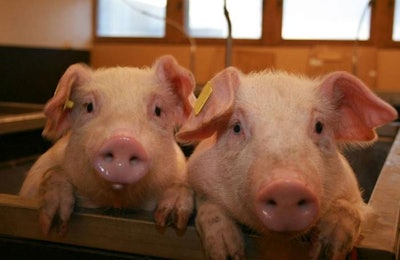
Conditions affecting weaned pigs and feeder pigs are far less understood than loss of market hogs. While sow performance can often have an impact on piglet mortality, other factors, like transportation, may create loss for producers as well. Pigs respond differently to transportation at different ages. Transportation of pigs at an early age could potentially result in revenue loss and mortality due to stress from less than ideal transportation conditions.
Jay Harmon, PE, professor at Iowa State University, released a study analyzing transportation conditions and the affects they have on swine. Over 7,000 loads of hogs (weaned and feeders) were studied to find the factors resulting in mortality during transportation. Weaned pigs experienced a death loss greater than feeder hogs. This could be a result of not only the stress from transportation but also the combined stress of weaning.
Pigs respond differently to transportation at different ages.
Mild weather conditions (59 F to 77 F) seemed to be ideal, as those conditions resulted in the lowest death toll for both ages of pigs. However, in warmer conditions, weaned pigs showed more signs of stress and mortality. The longer the distance, the higher the mortality rate was for both age groups. Weaned pigs did, however, have a higher death rate the further the distance. “These results indicate that perhaps extra measures of heat stress reduction may be needed more for weaned pigs than are currently being implemented,” Harmon said.
The study also showed that pigs who endured transportation were more likely to have a higher death loss the second week after being placed in a finishing system, regardless of weather conditions. “This elevation of the second week mortality rates may be due to starve out of pigs that failed to thrive during the first week but lasted into the second week,” said Harmon. The longest travel distance didn’t result in the highest post transportation mortality rate. Deaths in the second week were highest after pigs traveled a distance between about 750 to 930 miles. However, there is not a definite link between these deaths and transportation, other environmental factors could be involved.
Piglet mortality rate
Average piglet mortality per litter is between 16 and 20 percent, which is about two piglets per litter, according to Free Farrowing, an information resource primarily for pig farmers. While farrowing management can minimize loss, it does not eliminate future risk.
There are strong relationships between pig age, weather conditions and travel distances in mortality rate. Weaned pigs tend to have a greater disadvantage in survival rate. “Higher weaned pigs’ death rates presumably arise from the exacerbated stress (from both weaning and transport) and less developed immunological and physiological systems,” Harmon said.
According to the Texas Tech University Laboratory of Animal Behavior, Physiology and Welfare, transportation is hard on swine for multiple reasons. While Harmon discussed age, temperature and distance in his study for why transportation of young hogs affects mortality, The Pig Transport Site (run by Texas Tech) also lists human interaction before loading; bright sunlight if hogs were raised inside; footing and flooring; ramping systems; fencing materials that may be new to them; and vibrations and movement that may result in motion sickness.
With higher mortality, producers may consider ways to reduce stress during transportation in order to increase total revenue.

















